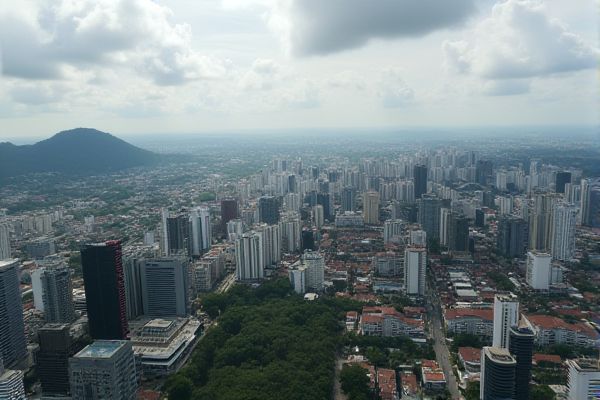
Safety and crime rates in Indonesia: Varied crime rates across provinces. Petty theft is common in tourist areas. Police presence varies by region. Check local advisories and news. Emergency services might be limited. Safety varies between urban and rural. Traffic accidents are frequent. Natural disaster preparedness is crucial. Cultural norms affect safety perceptions. Expats often live in secured communities.
Varied crime rates across provinces.
In Indonesia, crime rates vary significantly across provinces and regions; for example, in East Kalimantan, the crime rate in 2023 was highest in Bontang with 261 cases per 100,000 population, highlighting regional disparities in crime rates. For more detailed statistics and analysis on this, you can explore the comprehensive data on Statista. This data underscores the complex challenges faced by local authorities in addressing crime and maintaining public safety across different areas of the country.
Petty theft is common in tourist areas.
Petty theft, including pickpocketing, bag snatching, and credit card fraud, is common in tourist areas of Bali, particularly in crowded spots like malls, Oberoi Street in Seminyak, and Batu Bolong in Canggu. Tourists should be vigilant with their belongings and take basic precautions to minimize the risk of theft. For more insights and guidance on staying safe in Bali, visit the Remote Year blog for detailed information.
Police presence varies by region.
In Indonesia, police presence and organization vary by region, with the Indonesian National Police (POLRI) overseeing a hierarchical structure that includes Regional Police (Polda) at the provincial level, Departmental Police (Polres) at the city or regency level, and Sectoral Police (Polsek) at the district level, each with different ranks and responsibilities. This structure ensures that Law Enforcement in Indonesia is tailored to the specific needs of each area, but the effectiveness and presence can differ significantly across various regions.
Check local advisories and news.
Exercise increased caution while traveling in Indonesia due to the heightened risks of terrorism and natural disasters. Regions such as Central Papua and Highland Papua are notably perilous, with prevalent threats like kidnapping and violent demonstrations. Additionally, other parts of the country contend with terrorism, violent crime, and petty crime. The Indonesia Travel Advisory underscores the necessity of heightened vigilance amid ongoing political and social tensions and advises travelers to adhere closely to local authorities' instructions to ensure safety. Provinces like Indonesian Papua and Aceh demand particular attention due to their security concerns, further compounded by general road safety issues throughout the nation.
Emergency services might be limited.
Emergency services in Indonesia, particularly prehospital emergency medical services, are fragmented and lack standardization, facing issues such as inadequate funding, poor coordination, insufficiently trained paramedics, and infrastructure deficiencies, which impact the quality and management of care delivery. For further insights on these challenges, visit the International Journal of Medical Research, which explores these critical issues in depth.
Safety varies between urban and rural.
In Indonesia, crime is more concentrated in urban areas, where travelers need to be cautious of petty theft, scams, and other forms of street crime. Conversely, rural areas generally have lower crime rates but may still experience issues like corruption and occasional violent incidents. For more information on this topic, you can visit the Travel Guide on safety and crime in Indonesia.
Traffic accidents are frequent.
Traffic accidents in Indonesia are a frequent occurrence, resulting in 30,668 deaths in 2020 and accounting for 1.81% of total deaths, with an age-adjusted death rate of 11.88 per 100,000 population. The high incidence is attributed to factors such as a high proportion of motorcyclists, speed differentials, and unsafe driving practices. For more detailed information, you can visit the World Life Expectancy website, which provides insights into the statistical data and contributing factors of these accidents.
Natural disaster preparedness is crucial.
Indonesia, being one of the most disaster-prone countries, has significantly improved its disaster management through a 10-year partnership with Australian governments, science agencies, and universities. This collaboration has enhanced hazard information, spatial data, and decision support tools, such as InaSAFE, to better prepare for, respond to, and recover from disasters like earthquakes, tsunamis, and volcanic eruptions.
Cultural norms affect safety perceptions.
In Indonesia, cultural norms strongly influence safety perceptions, emphasizing high values on collectivism, power distance, and uncertainty avoidance. Despite these cultural values, they do not necessarily lead to higher crime rates. Instead, they shape how people interact and respond to safety measures, with corruption and petty crimes being more significant concerns in urban areas. For more detailed insights about safety in Indonesia, visit the Indonesia Travel Guide which provides valuable information on crime and safety.
Expats often live in secured communities.
Expats in Indonesia often reside in secured housing estates, which are planned communities with enhanced security features such as guarded gates, wider streets, and recreational facilities. These communities provide a safer environment compared to typical neighborhoods. For more detailed information on these secured housing options, you can visit the Housing Estates page.
